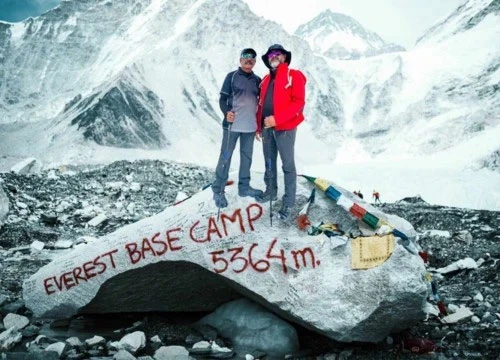Best season and time for Everest Base Camp Yoga Trek
The best seasons for Everest Base Camp Yoga trekking are Spring (March to May) and Autumn (September to November). While the trek can be done in any season all year round, spring and autumn are the most recommended times.
Spring is one of the best seasons for trekking in the Everest region, where the moderate temperature provides a comfortable walking environment. The clear skies, with an average temperature of 15 C (59 F), make the trekking experience relatively easier. The rhododendron flower becomes in full bloom during spring, making the forests lively. This creates a more comfortable scenario and a sense of relaxation during the trekking period. The day is more extended in spring, allowing for longer exploration time. The trails are relatively in good condition.
Another best season for trekking in the Everest is autumn. The sky is clear with appropriate weather conditions. The average temperature in the autumn months is -5 °C to 10 °C (23 °F to 50 °F), while the night temperature is lower. The mountains, landscapes, and vegetation come alive to show the sparking natural surroundings. The traditional sherpa villages, monasteries, glaciers, and water sources make the Everest base camp journey a mystical destination. The autumn season offers an unobstructed view of Lhotse, Everest, Ama Dablam, and Pumori.
Despite trekking to Everest in spring and autumn, Nepal faces two more seasons: winter and summer/monsoon. These seasons are less favored, and the number of trekkers could be higher. Trekking in the winter and monsoon is a challenge and comes with risk. Hiking in the monsoon and winter is possible but requires logistic preparation. During these seasons, the climate is extreme, with bone-chilling temperatures. The trails are covered with snow, and the skies are only frequently clear. Thus, trekking in these seasons is often recommended for expert trekkers who love to face challenges and like adrenaline.
So, anyone who intends to travel to Everest Base Camp Yoga Trek needs to keep the weather conditions in mind and travel accordingly. It is better to consult with Holiday Planner Nepal to prepare the travel itinerary for extreme weather, as they need a detailed work plan.
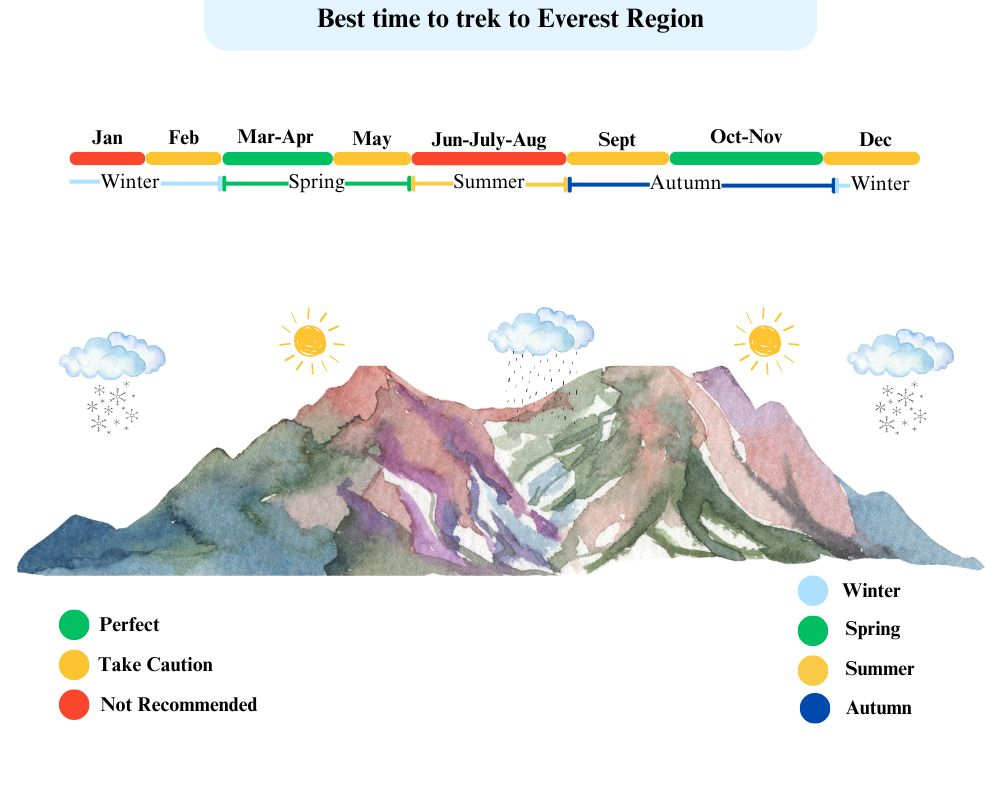
Fitness for Everest Base Camp Yoga Trekking
The Everest base camp is a moderate trek according to difficulty. Trekking to the base camp does not require prior expertise; however, proper physical and mental fitness is necessary.
Walking past the rugged trails, steep uphill, on the glaciers requires good stamina and endurance. A person who wants to trek to the Everest Base Camp must have good physical fitness. However, any hardcore trekking experience or prior knowledge is optional. Enrolling in cardio exercises like walking, jogging, swimming, cycling, and running is necessary before heading to the trek for one month. Avoiding lifts, taking the stairs, and walking for 45 minutes daily can be minor changes to prepare the body for trekking.
This high-altitude trekking also needs mental stability. As the trekking is on the remote side of Nepal, expect luxury only some of the way. The accommodation, food, and bathroom facilities might not meet someone's expectations, so it is necessary to keep an open mind. The trails can be hectic, the luggage may need to be a better friend, and communication can be troublesome; however, maintaining a solid mentality and adjusting small changes can help achieve one of the most memorable treks ever.
So proper physical fitness, good balance, endurance, and a strong mentality can significantly enhance the yoga trek in Everest. As there will be yoga sessions in different locations of the Everest region, one can keep a steady mentality and adjust to the high altitude accordingly.
Similarly, it is essential to note that individuals who have a long history of chronic disease and severe medical conditions like heart and lung disease should not attempt this trek. It is advised to go for some more accessible trekking packages like the Mardi Himal trek, Ghorepani Poon Hill trek, Langtang Valley trekking, Annapurna Base Camp trekking, and others.
Accommodation facilities
Accommodation facilities are crucial factors while trekking in the Everest region. The type of accommodation directly impacts the mentality of the trekkers. A proper night's rest after a long day of walking helps to regain fitness and reduce stress. Thus, appropriate accommodations with good amenities must be chosen.
There are a variety of accommodation types that can be selected to spend the night in the Everest region. Some of the accommodation options in the Everest region are as follows:
- Teahouses: these are the basic accommodation types in Everest. The teahouse provides a convenient facility with basic beds and blankets. Teahouses are small guesthouses with single or double beds. A room in the teahouse can accommodate up to 2–3 people at maximum. While they are the cheapest accommodation option, the bathrooms are shared. Showers in the teahouse can be buckets, geysers, or solar showers with hot water. However, showers in the teahouse always come with an extra cost.
- Guesthouses and hotels: These are more expensive forms of accommodation for trekkers, only available in densely populated areas or places with higher settlements. In guesthouses and hotels, the trekkers stay with the local families and savor the regional cuisines on the menu. This allows visitors to communicate with the people of the Solukhumbu area and get insights into their mountain life. A room in the guesthouse has only two beds where only two trekkers can rest. So, they work on one individual on a one-bed basis.
These guesthouses similarly provide good bed and blanket facilities; however, anyone who wishes to book rooms with attached bathrooms should book it in advance as such rooms are taken first.
- Luxury houses: As the name explains, these are the most lavish and most comfortable night options. However, luxury houses are present only in the prominent places along the Everest Base Camp route. Such hospitality and facilities come at a cost, so luxury houses are the most expensive accommodation options. Amenities like attached bathrooms, heating systems, hot showers, and delicious cuisines for breakfast, lunch, and dinner are available.
- Camping: Camping on Everest is also an option and is widely followed by many mountaineers and trekkers. Individuals who attempt the Everest summit camp mandatorily. However, those who wish to spend time close to nature in the lap of the Himalayas can also sleep while setting up the camp. Trekkers, guides, and porters can carry tents, sleeping bags, and other equipment required for camping. Thus, it is understandable that camping during the Everest Trek requires more logistic preparation and careful planning.
We have the option of providing rooms with electric blankets and attached bathrooms at an additional cost of $400 per person. These types of lodges are not luxurious lodges, but they are comfortable lodges compared to normal and basic lodges and are warm and comfortable. Places like Phakding, Namche, Tengboche, Debouche, and Dingboche offer these facilities. For the last two days at Gorakshep and Lobuche, attached bathrooms have not been available, but electric blankets are available, which work through solar panels. In case the blankets are not working, we provide hot water bags to all the clients and trekkers.
Communication and electricity facilities at the Trail of Everest
Communication, Charging, and Electricity will be of significant importance while going to any region for traveling, and Everest is no different. As Everest comes under high-altitude trekking, communication, and electricity facilities may be compromised in certain sections. Due to the remoteness, the communication tower may not work at high altitudes or inside forests, and some passes, besides this communication facility, are effortless.
Holiday Tours Nepal provides a sim card that is free of cost and has 20 GB of data. This will help you communicate and surf data until your stay in Nepal.
Charging and electricity are available in all the accommodations. Cell phones and cameras can be charged in personal rooms of lodges, hotels, guesthouses, and luxury houses. However, anyone residing in the teahouse must charge their devices in the hotel lobby. Charging in the teahouse comes with an extra cost, ranging from 3 to 5 USD. During the trekking route and camping, charging is not an option, so carrying power banks, a different set of batteries, and solar chargers is advisable to have an undisputed power supply.
Permits and Documents required for Everest Base Camp with cost
The Everest Base camp lies in the Khumbu region, which the Government of Nepal labels as a protected area. So, various permits and documents are required to enter the area, and they must be made as multiple check posts and permit points thoroughly check the records. The following are the permits for trekkers, nature lovers, and adventurers to reach the Everest Base Camp.
Tourists and SAARC nationals can get this permit by paying NRS 2,000 per person, valid for the first four weeks. However, if the travel extends for more than four weeks, the permit cost is NRs. 2500 per person. Similarly, this permit can be obtained in Lukla.
Foreign nationals must pay NRs 3,000 per person to enter the Sagarmatha National Park, a protected area under the Khumbu region. However, the cost of the permit is NRs. 1,500 for SAARC nationals. Similarly, children who are under the age of 10 do not require this permit. Visitors can obtain their permit in Kathmandu at the Nepal Tourism Board Office or Sagarmatha National Park entry point in Monjo.
The TIMS card is a required document for the safety of all trekkers. The TIMS card helps to maintain a record of the trekkers and their destination of travel to update the information to the authorities in case of unforeseen circumstances during the trek. The cost of a TIMS card is projected below:
Tourists outside SAARC country
NRs. 1,000 (about US$ 10) per trekking route, per participant, per entry for group trekkers and NRs. 2,000 (about US$20) per trekking route, per participant, per entry for individual trekkers.
Tourists of the SAARC country
NRS. 300 (about US$ 3) per trekking route, per person, per entry for group trekkers and NRs. 600 (about US$ 6) per trekking route, per participant, per entry for individual trekkers.
- Passport
- Other documents
- Valid Visa to Nepal
- Two copies of Passport Size Photo
Altitude Sickness during Everest Base Camp Yoga Trekking
Acute Mountain Sickness (AMS), also known as Altitude Sickness, is a common problem for individuals who trek in the high-altitude region. The leading cause of altitude sickness is rapid ascent to higher elevations without enough time for acclimatization. The body needs to adapt to reduced oxygen levels at higher altitudes. The common symptoms can be a headache, dizziness, nausea, fatigue, loss of appetite, and shortness of breath. However, if necessary precautions are not taken, things might be complicated. Some of the extreme forms of AMS are high-altitude pulmonary edema (HAPE) and high-altitude cerebral edema (HACE).
HAPE affects the lungs and causes them to fill with fluid, which is not the most severe form, but it can cause severe health problems.
Similarly, HACE is the most severe form, where altitude sickness causes the brain to swell. This is the most dangerous condition and requires immediate emergency care.
Note: If any uneasiness or discomfort in the health condition is felt while trekking in the Everest region, it is advisable to seek immediate assistance. The condition must be shared with the guide, who is an expert in such a condition.
Holiday Tours Nepal has the following points prepared to prevent altitude sickness during the yoga trek in Everest:
- Acclimatization: It is necessary to deal with lower oxygen levels at higher elevations. This means that people must rest frequently before rising to more significant elevations. This will familiarize the body with the environment, which will help to lessen the likelihood of altitude sickness. It is also advised to gain at most 300–500 meters of height each day and to relax every 3–4 days.
- Hydration: Stay hydrated to avoid dehydration, which may worsen altitude sickness. Trekkers should avoid caffeine and alcohol because they dehydrate the body.
- Medicine: To avoid altitude sickness, eat garlic soup or consider taking medication. Before beginning any medicine, consult your doctor and ensure you take the correct dosage.
- Descend: If you begin to experience symptoms of altitude sickness, descend quickly to a lower altitude. Stop climbing as soon as your symptoms have eased.
- Determine Symptoms: If you see any of the symptoms of altitude sickness, notify your guide or hiking partner. Symptoms include headache, nausea, vertigo, and dyspnea.
- Fitness: To prepare for the physical demands of the climb and to reduce your chances of altitude sickness, train properly before the hike. This will improve your endurance and fitness level.
Is Travel Insurance Necessary?
Anyone planning to tackle the Everest Three Pass Trekking route should get travel insurance. This type of insurance can cover many hazards and unanticipated scenarios that may develop when hiking. Keep the following considerations in mind while purchasing travel insurance for the Everest Base Camp Yoga Trekking:
- Medical insurance: Check that coverage covers medical expenses, which can be costly at high heights, such as emergency medical care and evacuation.
- Trip interruption and cancellation: Purchase trip cancellation and interruption insurance to protect yourself in unforeseen events, such as illness, injury, or natural catastrophes, forcing you to postpone or cancel your holiday.
- Lost or stolen items: Look for insurance that covers lost or stolen items such as gear, equipment, and personal things.
As some insurance policies do not, check to see if the policy covers high-risk activities like trekking and mountaineering.
Search for coverage that provides round-the-clock emergency help in a medical or other emergency.
Pre-existing conditions: Check to see if the insurance covers your pre-existing medical conditions or if you can get a waiver if you have any.
How is the rescue done in the Everest region?
There are two types of policies. The first one is in which the trekkers pay first and get paid back by the insurance company, and the other is in which the insurance company pays up all the amount upfront.
For rescue, the helicopter charges $5500 for chartering it from Everest Region to Kathmandu. Then, from the airport, the trekkers are taken to the hospital in an ambulance, and the doctors and nurses take over from there. The patient is kept in the hospital for observation and treatment and is discharged when the hospital gives discharge clearance.
Holiday Tours Nepal Exercise and preparation routine for attempting Everest base camp trek
Week | Focus areas | Activities | Details | Remarks |
Week 1-2 | Building base for the trek | Cardio, strength and flexibility | Cardio: 3-4 days/week: Brisk walking, cycling, or jogging (45-60 minutes)
Strength: 2-3 days/week: Squats, lunges, step-ups, planks (3 sets of 12-15 reps)
Flexibility: Stretching or yoga (20 minutes after each workout) | Helps to build the base that will help for building endurance and stamina. |
Week 3-4 | Strengthening the Legs | Hiking, Strength, Core | Hiking: 2-3 days/week: Hike on an incline or treadmill (1-2 hours). Start carrying a light pack (5-10 lbs.)
Strength: 2-3 days/week: Squats, lunges, step-ups with weight (10-15 lbs.)
Core: Planks, leg raises, Russian twists (3 sets of 20 reps) | Helps to develop strength and make the legs stronger which will help for the hike during the trek. |
Week 5-6 | Increasing Intensity | Endurance, Weight Training, Hiking | Hiking: 2-3 long hikes (3-4 hours) with weight (10-15 lbs.). Focus on incline and rocky terrain
Cardio: Running or cycling for 45-60 minutes (2-3 times/week)
Strength: Weighted squats, lunges, step-ups, core work (3 sets of 12-15 reps each) | Helps to build further endurance |
Week 7 | Endurance & Simulation | Long Hikes, Full Body Strength | Long Hikes: 1-2 long hikes (5-6 hours) with heavy pack (15-20 lbs.), focus on uphill and varied terrain. Include stairs if possible
Strength: Full body exercises (weighted squats, lunges, step-ups, planks)
Core: 3 sets of planks, side planks, mountain climbers | Helps for building endurance for long hikes and helps for stamina. |
Week 8 | Peak Intensity & Recovery | Simulation, Light Cardio | Simulation: 1 long hike (6-7 hours) with a full pack, focus on staying hydrated and fueled
Cardio: Light running or cycling (30-40 minutes)
Recovery: Stretching, yoga, light walking for flexibility and muscle relaxation | Helps for stretching, flexibility and preparation before and after hike |
Week 9 | Breathing training | Nose and mouth breathing patterns. | Box to box breathing, navy breathing, nasal breathing, belly breathing, 4-7-8 breathing, pursed lip breathing, coherent breathing, bhastrika breathing | Helps for breathing in high altitudes |
Tips for trekkers who are trekking in the Himalayas
Tips for female travelers during periods in the mountains
Know your cycle and pack accordingly sanitary pads, period underwear’s, menstrual cups and tampons.
Pack sanitary pads in case sometimes the dates can be up and down and even someone might need in trek in case you don’t use it.
Bring pain relivers like ibuprofen, heat patches, to ease cramps stay hydrated and eat good nutrition food.
- Wear comfortable and food layered clothing’s rest when needed and mind your mood.
Equipment and Gear List
 General
General
- Four-season (-20 degree) sleeping bag (We provide rental sleeping bags available for an additional USD 35)
- Puffy down jacket (We provide rental jackets for an additional USD 35)
- Daypack (25-30 liters recommended) with rain cover
 Upper Body
Upper Body
- Sun hat or cap (We'll provide you with a trekking cap.)
- Warm woolen hat
- Scarf/Neck Buff (highly recommended to get saved from wind and cold)
- Headlamp or mobile torch light for nighttime
- Polarized sunglasses
 Torso
Torso
- Technical fabric base layer thermals are light for warmer months, heavy for colder months
- Technical fabric t-shirts and sleeve sweaters or high-necks
- Waterproof rain jacket
- Windproof jacket for the walk as it gets windy
- Fleece jacket or down jacket
 Lower Body
Lower Body
- Thermals inner
- Hiking pants at least 3
- Comfortable pants for teahouses
- Waterproof, windproof shell
- Hiking shorts
 Hands
Hands
- Woolen gloves for the tea house
- Hard-shell windproof outer gloves for the walk
 Feet
Feet
- Marino Wool or comfortable, warm socks
- Hiking socks
- Liner socks
- Trekking/hiking boots (waterproof recommended)
- Crampons (For passes)
- Casual shoes or sandals that are comfortable for the time in the tea house
- Gaiters (lightweight for rain and snow)
 Undergarments and Inner Wears
Undergarments and Inner Wears
- Technical fabric/quick drying (can be washed during the trek)
- Sports bras (women)
- Sleeping clothes as per the comfortability
 First Aid Kits and Medications
First Aid Kits and Medications
Note: Our guides carry medications, oxygen cans, and first aid kits during the trip. However, personal kits and medications are recommended.)
- Sunscreen SPF- 50+
- Lip balm or Vaseline
- ointment cream
- Cough Syrup and strepsils (recommended for Khumbu Cough)
- Creams and medicines (for any allergies or diseases)
 Other Essentials
Other Essentials
- Passport
- Extra copies of passport-sized photos
- Reusable water bottle
- Toilet paper, small soap, and shampoo
- Water purification tablets or UV water purifier (if you plan to treat water)
- Water bladder for the day bag
- Small towel for personal use
- Pillowcase in case of allergies to new pillows
- High-protein snacks (such as mountain bars or nuts)
- Waterproof/dry bags for carrying essential documents, stuff, frequently used items, and money
- Power bank or extra batteries
- Cameras and mobile phone
- Cards/book
- Pee bottle/ pee funnel for women
- Trekking poles
- Whistle in case your voice is not loud enough to stop or start
- Thermos for hot water during the nighttime
- We give you a free duffel bag, trekking cap, maps, and t-shirt during your pre-trip meeting in Kathmandu. The duffel bag will be used to pack your trekking supplies.
- For every two participants, we assign one porter. The porter will carry the duffel bag, which should weigh around 10 kg/22 lbs., throughout the walk.
- Daypack bag for daily used stuff like cash, documents, papers, a water bottle or bladder, a camera, toiletries, sunscreen, a notebook, clothing, etc. (with a waterproof cover).
- You can store your luggage (on-trekking items) at the hotel in Kathmandu, and we can assist and help.
- Total luggage for the Kathmandu-Lukla flight is (15 kg/33 lbs.), including duffel (10 Kg/22 lbs.) and backpack (5 kg/11 lbs.)
- A down jacket with a hood(cap) to be warm in altitudes above 3,000m.
- We can provide a down jacket for USD 35. In case of loss or damage, you need to pay back the cost of USD 200 per item.
- We can provide a sleeping bag for USD 35. In case of loss or damage, USD 200 per item must be paid.
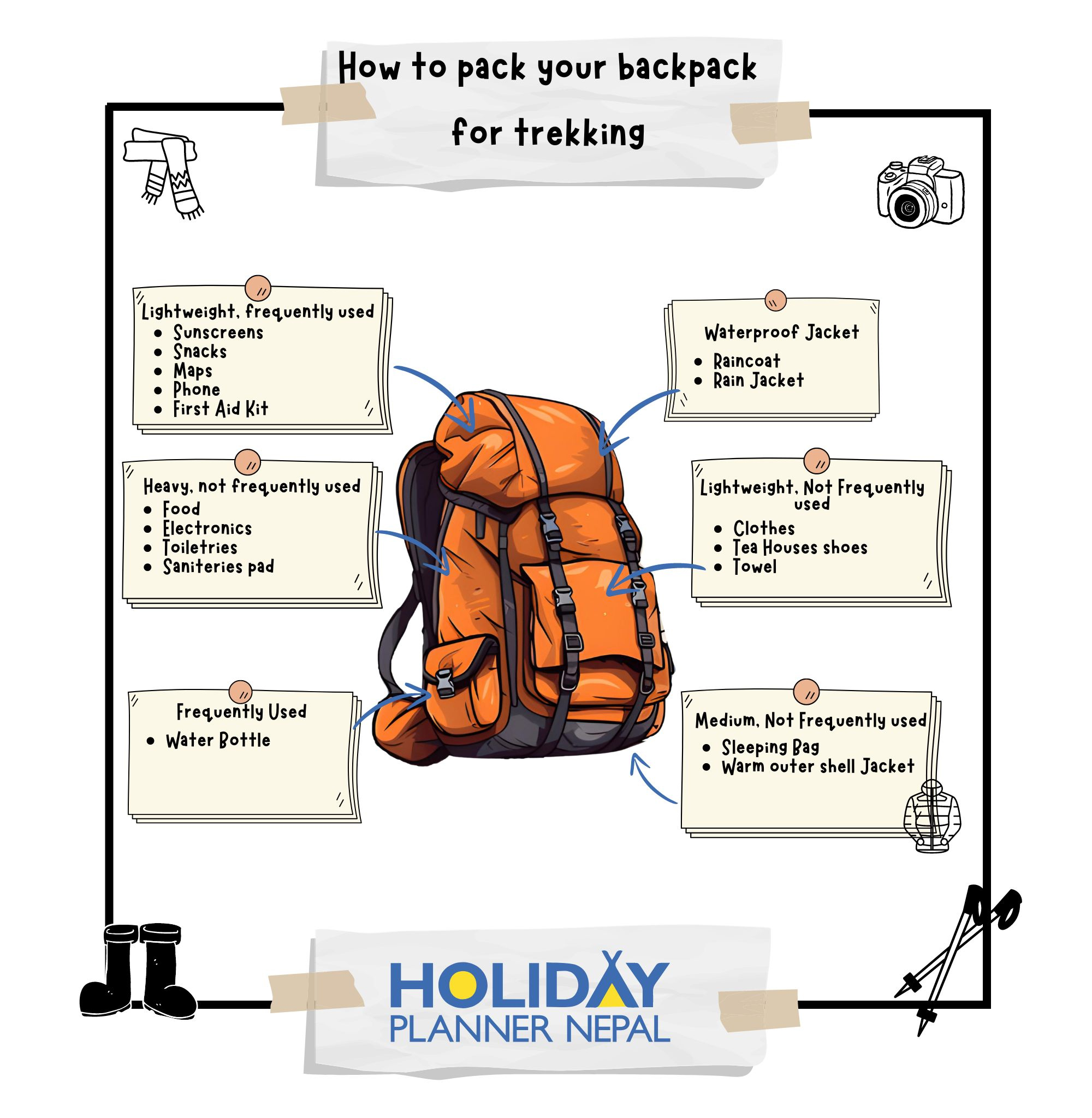
Note: Supplies and gear can be rented or purchased in Kathmandu. Once you are in Nepal, you can buy supplies and gear for hiking if you have spare time. Trekking Planner Nepal representatives will assist you in purchasing the equipment. Thamel a tourist hub, offers a wide range of trekking equipment at affordable prices. Don't wear short clothes inside the monasteries and religious places.
Tips for responsible tourism and respecting local culture at Everest region
- Walk through the left.
- Dress modestly wears long clothes.
- Be polite and engage with the locals with a respect.
- Avoid flashy displays be modest with wealth, technology and the body.
- If someone or someplace deserves a donation show case your love for the community.
- Don't shoot videos and photos inside the monasteries.
- Don't keep your feet over the mantra engraved stones.
- Respect the locals.
- Ask permission before taking pictures.
- Hire the local trekking agencies.
- Buy and support locals by using their local products.
- Avoid leaving trash or any waste behind and carry your waste to the designate bins.
- Avoid the use and throw of plastic bottles on the trail fill up you bottle and throw the bottle in the designated bins.
- Do not pick plants or disturb the wildlife.
- Don’t take things from the nature.
- Limit the use of fire woods and conserve the water. (woods cannot be used for fire)
Charging plugs availabe in Nepal
- Use an adapter that uses types D, C, and M. Universal multi plug adaptor is acceptable as well.
- Charging costs extra in the mountains, and the cost varies according to the place.
- Bring a power bank of at least 10,000 Mah.
- Leave your power bank on charge rather than the smartphone.
- Phones must be charged at reception where the multiplugs are.
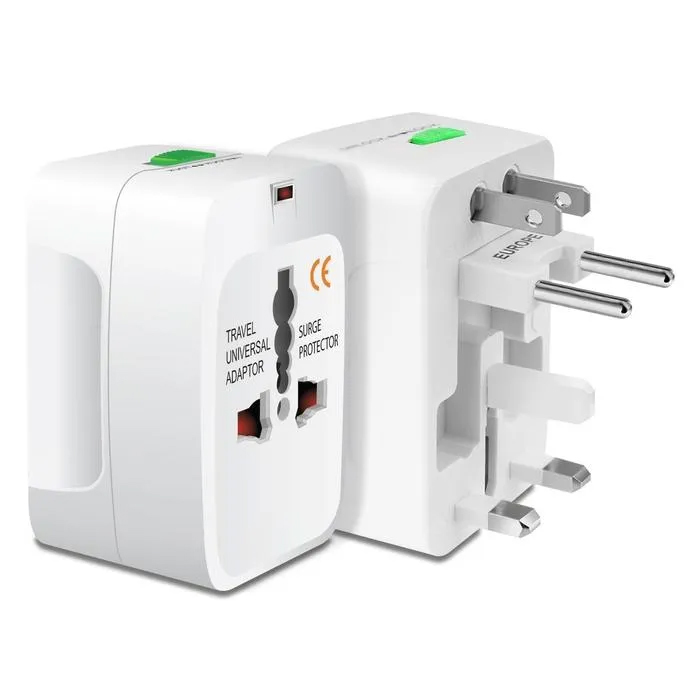
Advantage of Booking EBC Yoga trek with Holiday Planner Nepal
- Pick-up and drop-off services for all passengers upon international arrival and departure.
- Well-trained, experienced, fluently English-speaking guide, and a strong sherpa or porter for carrying the duffel bag.
- Welcome dinner upon arrival with cultural Nepali dances.
- Three meals a day and tea or coffee during the trek, with accommodation in the mountains.
- First-aid kit box and first-aid services.
- We provide Holiday Planner Nepal’s maps, t-shirt, and cap.
- Down jackets and sleeping bags are available for rent.
- We organize custom services as per the requests of our clients.
- Arrangement of emergency evacuation service (must be paid by the client or insurance).
- We provide an oximeter to check your pulse, oxygen saturation, and heart rate.
- We provide oxygen cans during high-altitude treks.
- We provide SIM cards for travelers, so there won’t be any communication issues.
Conclusion
The Everest Base Camp Yoga Trek is more than a high-altitude adventure—it’s a mindful journey that blends Himalayan beauty with the healing power of yoga, meditation, and breathwork. Whether you’re seeking spiritual growth, better acclimatization, or a deeper connection with nature, this transformative experience offers the perfect balance of wellness and exploration. With peaceful yoga sessions, Sherpa culture, and the iconic trek to Everest Base Camp, this trip stands out as one of the most rewarding trekking and yoga retreats in Nepal.
Ready to turn your dream into reality?
Plan your Everest Base Camp Yoga Trek with Holiday Planner Nepal today and let us create the perfect wellness adventure for you.


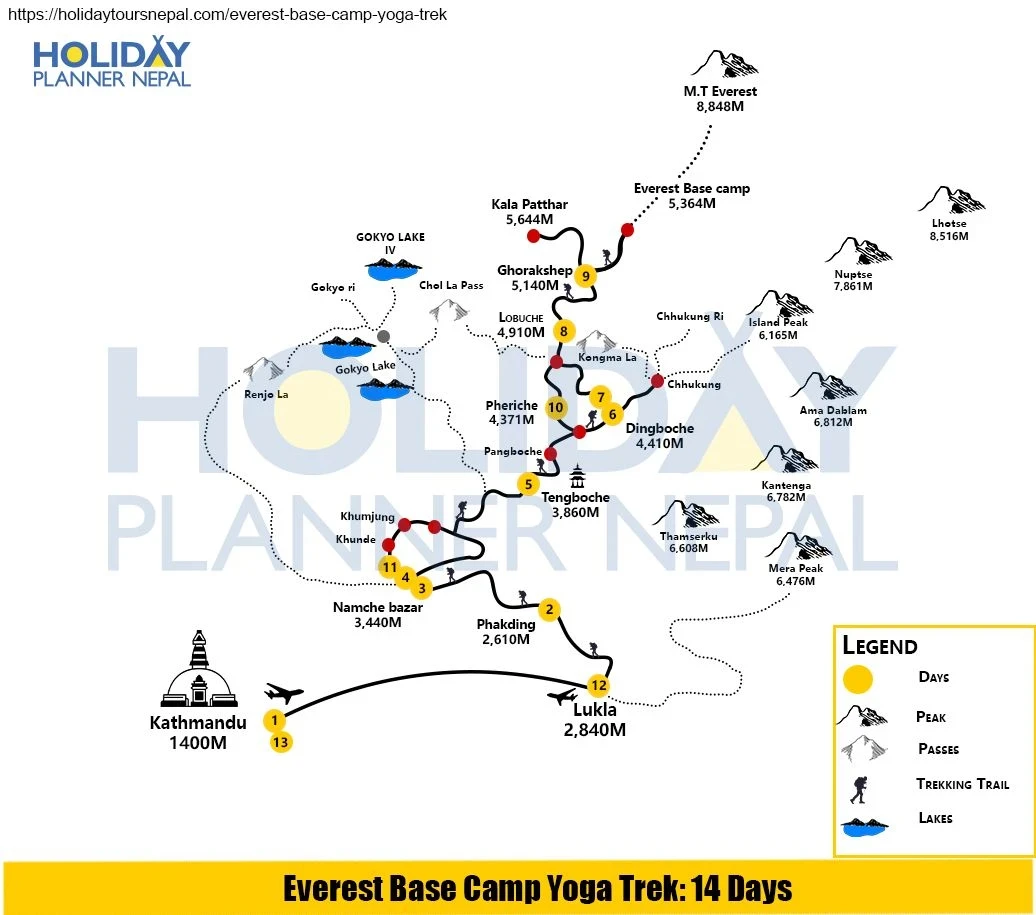

 General
General Upper Body
Upper Body Torso
Torso Lower Body
Lower Body Hands
Hands Feet
Feet Undergarments and Inner Wears
Undergarments and Inner Wears First Aid Kits and Medications
First Aid Kits and Medications Other Essentials
Other Essentials




